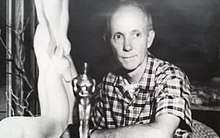George Stanley (sculptor)
George Maitland Stanley (April 26, 1903 – May 11, 1970)[1] was an American sculptor. He designed the Academy Award of Merit, also known as the Oscar, as well as sculpting the Muse Statue at the Hollywood Bowl.[2][3]
George Stanley | |
|---|---|
 Stanley with the statuette he sculpted in 1959 | |
| Born | George Maitland Stanley April 23, 1903 |
| Died | May 11, 1970 (aged 67) |
| Nationality | American |
| Education | Otis Art Institute |
| Known for | sculpture |
Early life
Stanley was born in Iota, Acadia Parish, Louisiana in the year 1903. He then moved as a child to California and spent his youth there in the city of Watsonville. Upon graduation from high school Stanley proceeded to study sculpture at Otis Art Institute in Los Angeles from 1923 to 1926. He also taught at this school from 1926 to 1942. Stanley also taught briefly at the Santa Barbara School of the Arts. During his life he completed many public arts works including work for schools such as the Long Beach Polytechnic High School, as well as works for private patrons.
Sculpting career
The Oscar statuette was fabricated based upon a sketch by MGM art director Cedric Gibbons in 1927. Since then, more than 2,300 statuettes have been presented to some of the world's best film and television actors, writers, directors, producers, and technicians.[4][5] Stanley sculpted a statue of Sir Isaac Newton located at the Griffith Observatory, completed in 1934. This statue was part of a larger work known as the Astronomer's Monument. This work was a public project funded by the PWAP. Consequently, the work was signed "PWAP", with none of the six artists contributing to it receiving individual recognition. The design for the monument was submitted by Archibald Garner, and executed by him and five of the other sculptors who had submitted proposals. Stanley designed the Oscar award based on an original sketch by Cedric Gibbons. It was first awarded in 1929. Stanley sculpted the Muse of Music, Dance, Drama located at the Hollywood Bowl which serves as the gateway to Hollywood.[6] Completed in 1940, this fountain sculpture in the Streamline Moderne style is carved from granite and stands twenty-two feet tall and two-hundred feet wide. It serves as a retaining wall for the amphitheater.[7] In June 2006, the sculpture was refurbished and rededicated. It received new plumbing, landscaping and grout.[8]
References
- http://www.askart.com/askart/artist.aspx?artist=10051346
- Nichols, Chris (February 25, 2016). "Meet George Stanley, Sculptor of the Academy Award". Los Angeles Magazine. Retrieved November 6, 2017.
- "Muse of Music, Dance, Drama". Los Angeles County Arts Commission: County Collection. LA County Arts Commission. Retrieved November 6, 2017.
- Gordon, Paul (March 21, 2002). "Design choice: Oscar". Marketing (10). ProQuest 214981600.
- "Phil's Stock World: The Oscars – Gold Plated And Debased Like The Dollar". Phil's Stock World. February 26, 2017.
- Pool, Bob (June 20, 2006). "Getting a Splash from the Past". Los Angeles Times. pp. B1.
- "George Stanley, "Muse of Music, Dance, Drama"". USAD Art Resource Guide:Art of the Great Depression. The United States Academic Decathlon: 55. 2010.
- "Hollywood Beauty Gets a Makeover". Los Angeles Times. June 17, 2006. pp. B11.